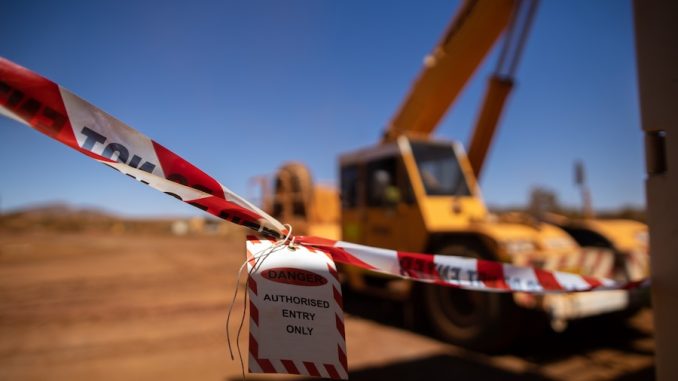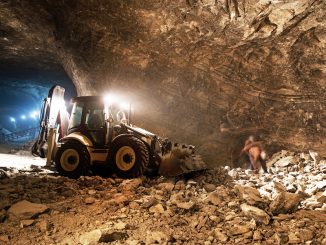
View the complete article here.
This guide highlights a series of real, OSHA-recorded incidents that underline the paramount importance of stringent safety measures in workplace environments—particularly those involving heavy machinery and high-risk operations. Each case, from devastating construction site accidents to fatal encounters with industrial equipment, serves as a sobering reminder of what can go awry when safety protocols are disregarded or insufficiently enforced.
Dozer Accident Claims Life at Construction Site
On November 6, 2023, a fatal accident occurred at a construction site—resulting in the death of an employee. The incident unfolded at 8:20 a.m. when the employee exited a dozer to direct a dump truck driver on stone placement for road grading. Failing to engage the safety lever upon exiting, the dozer unexpectedly started moving forward. In an attempt to stop it—the employee reached back into the cab, but the dozer reversed rapidly—knocking him down onto the treads and dragging him to the rear where he was tragically run over. The employee succumbed to multiple blunt force injuries, highlighting the imperative need for strict adherence to safety protocols and proper engagement of safety features on heavy machinery. OSHA Case No. 164535.015.
Death by Stump Grinder
On March 22, 2009, a tragic event occurred involving an employee of a tree service business. After completing a stump grinding task, Employee #1 was maneuvering the stump grinder away from the woodchip pile when the machine slipped on the chips. This slip caused the grinder to catch his leg—resulting in severe injuries including the loss of his right leg above the knee, his left hand above the wrist, and additional abdominal injuries. Unfortunately, Employee #1 did not survive the injuries sustained in this accident. This incident underlines the extreme hazards associated with operating stump grinders and the importance of ensuring stable ground conditions when moving such heavy equipment. OSHA Case No. 200925261.
Worker Crushed by Pump Jack Counterweight
On the morning of October 5, 2023, an incident unfolded at an active pump jack site where a crew had just completed servicing. As the team was finishing work—one of the employees, after tightening bolts on the stuffing box and performing lubrication tasks, moved from his working position to another part of the pump jack. Tragically, while he was standing beside the pump jack, the counterweight caught his shirt—dragging him down, where he was crushed between the counterweight and the pump jack’s frame. This highlights the critical need for spatial awareness around moving equipment and the implementation of safety measures to prevent contact with hazardous moving parts. OSHA Case No. 0627700.
Skidder Accident While Descending Hill
On November 16, 2023, a fatal incident occurred involving an employee of a tree care company. While operating a skidder on a steep hill, the employee failed to make a critical left turn and continued straight instead. The skidder left the fire road, struck several trees, and plunged into a 5-foot deep ditch. A coworker witnessed the employee collapse next to the skidder, suffering from fatal blunt force trauma to the chest. This accident highlights the necessity for comprehensive training and strict adherence to safety protocols in challenging environments. OSHA Case No. 161702.015.
Electrocution from Power Line
In Killbuck, Ohio, on September 6, 2023, a 46-year-old employee faced a fatal incident while working near energized power lines. While installing a fiber optic cable—the proper electrical protective equipment, such as rubber insulating gloves, was not utilized. This resulted in the man’s electrocution from an overhead powerline carrying 7,200 volts. This accident highlights the critical importance of using appropriate protective gear when working in proximity to electrical hazards. OSHA Case No. 1696185.
Incident Involving Flagger and Dump Truck
On November 15, 2023, an accident at a construction site resulted in the death of a flagger. The incident occurred at 3:41 p.m. when the flagger was struck by a dump truck that was backing up without a functioning backup alarm. The employee was hit by the rear four tires of the double-axle truck and suffered fatal blunt force trauma. Emergency medical services were quick to respond but were unable to resuscitate the employee. This accident highlights the vital need for proper safety equipment and protocols, particularly functioning alarms on large construction vehicles. OSHA Case No. 161959.015.

Chainsaw Accident at Logging Site
A fatal accident occurred on November 10, 2023, at a logging site—resulting in the death of an employee. At 10:00 a.m., while walking towards felled trees with an idling chainsaw, the employee tragically tripped and fell onto the saw blade—causing a severe laceration to his neck. The injuries were fatal. This incident underscores the critical importance of ensuring that all walking paths are clear and safe, and highlights the need for carrying safety protocols when handling dangerous equipment such as chainsaws. OSHA Case No. 161545.015.
Scissor Lift Incident at Construction Site
On the morning of November 2, 2023, an incident at a construction site operated by a framing contractor resulted in the death of an employee. At 8:45 a.m., while removing a scissor lift from the third story of a new metal-framed building, the lift began to overturn during its relocation using a rough terrain fork truck. Employee #1, who was assisting by giving hand signals to the fork truck operator, was caught by the top rail of the tilting lift and pinned against the concrete floor. Despite being promptly transported to the hospital, Employee #1 succumbed to traumatic injuries to the head and back. This accident underscores the critical need for rigorous safety checks and proper handling techniques when operating heavy lifting equipment in construction environments. OSHA Case No. 161400.015.
Powered Industrial Truck Accident at Smelting Company
An incident occurred at a smelting company on October 12, 2023, resulting in the death of a plant operator. At approximately 3:30 p.m., the employee was operating a powered industrial truck (PIT) within the secondary smelter plant when a collision with a front-end loader operated by a coworker caused the PIT to overturn. The employee was ejected from the vehicle and suffered fatal chest injuries upon impact with the ground. This accident highlights the critical need for stringent safety protocols and traffic management within industrial settings to prevent such collisions and ensure the safety of all operators of heavy machinery. OSHA Case No. 160708.015.
Trench Accident Involving Excavator Bucket
A fatal accident occurred on October 31, 2023, at a site managed by a residential contractor—resulting in the death of an employee. While working in a shallow trench at 11:00 a.m., the employee was positioned between a prefabricated concrete manhole and an excavator. Unexpectedly, the excavator’s bucket moved forward and struck the employee, causing fatal blunt force trauma. This incident highlights the urgent need for strict adherence to safety protocols around heavy machinery and the critical importance of establishing clear work procedures to prevent such accidents, particularly in trench and excavation settings. OSHA Case No. 161436.015.
Incident with Log Trailer at Forest Products Company
A tragic event unfolded on November 21, 2023, at a site operated by a forest products company—leading to the death of an employee. At approximately 8:30 a.m., the employee was attempting to release the airbrake on a log trailer that was fully loaded and parked on a landing. During this task, the log truck unexpectedly rolled backward—crushing the employee against the back of the trailer. Subsequently, the truck continued its backward trajectory down an embankment. Emergency services were promptly called to the scene, and despite quick transport to the hospital, the employee succumbed to injuries. This incident underscores the critical importance of ensuring that all vehicles are securely stabilized, particularly on uneven terrain—and highlights the need for comprehensive safety checks before performing maintenance or adjustments. OSHA Case No. 163149.015.
Rotating Drive Shaft Accident at Petroleum Products Wholesaler
A fatal accident occurred on October 27, 2023, at a petroleum products wholesaler—resulting in the death of a truck driver. At 6:30 a.m., after finishing his shift, the employee was inspecting something underneath a truck when he was tragically pulled into the power take off (PTO) pump drive shaft. It is believed that the rotating shaft caught a piece of his clothing, dragging him into the mechanism. This incident led to the employee’s death due to entanglement with the rotating equipment. This tragic event highlights the critical need for strict safety protocols when working near mechanical parts and the importance of ensuring all rotating equipment is fully secured before any inspection or maintenance is performed. OSHA Case No. 161205.015.
Crane Boom Collapse at Construction Site
A fatal accident occurred on October 23, 2023, at a construction site managed by a heavy civil contractor. At 9:00 a.m., while employees were disassembling a crawler crane, a critical error was made in the removal order of the pins—and proper blocking was not used. This oversight led to the collapse of the crane’s boom section, which struck and fatally injured an employee. The individual was pinned between the boom and the ground. This tragic incident underscores the importance of following strict procedural guidelines and safety measures during the disassembly of heavy equipment to prevent such accidents. OSHA Case No. 161037.015.
Forklift Incident at Freight Shipping Company
A fatal accident occurred on August 22, 2023, at a freight shipping company, where an employee was killed in a forklift accident. While operating the forklift at 3:30 a.m., the employee was scanning a piece of freight and inadvertently backed off the loading dock—falling to the ground level with the vehicle. The fall resulted in multiple severe injuries—including head and facial trauma, neck hemorrhaging, multiple rib fractures, a laceration to the right lung, hemorrhaging in the chest cavity, and an L4 vertebrae fracture. This tragic event underscores the importance of safety measures at loading docks and the need for continuous training on equipment operation to prevent such accidents. OSHA Case No. 159235.015.
Tragic Trench Collapse at City Water Department
A catastrophic trench collapse occurred on October 21, 2023, at a city water department—resulting in the death of an employee. At 3:00 a.m., the employee was engaged in maintenance work inside a trench. Straddling a water line and removing bolts, the trench’s walls suddenly gave way. The collapse buried the employee under a heavy mass of dirt, rock, and sand—leading to fatal crushing injuries and suffocation. This incident highlights the critical importance of trench safety measures, including proper shoring and monitoring of trench stability, to protect workers from such dangers. OSHA Case No. 165251.015.
Final Thoughts
This compilation of workplace accidents underscores the critical importance of rigorous safety protocols and adherence to best practices in industrial and construction settings. From ensuring proper machine operation to securing loading docks and stabilizing vehicles, each case highlights specific areas where attention to detail can mean the difference between safety and catastrophe. As a reminder—always ensure that safety equipment is functional, conduct regular training sessions for all employees, and prioritize the establishment of clear communication during all operations. These measures not only enhance safety but also foster a culture of vigilance and responsibility that can significantly reduce the likelihood of fatal incidents.
View the complete article here.
What are some common causes of construction accidents?
Common causes include improper use of heavy machinery, lack of safety training, and failure to follow established safety protocols.
How can construction companies improve workplace safety?
They can improve safety by conducting regular safety audits, providing comprehensive training programs, and ensuring strict adherence to safety protocols at all times.












































